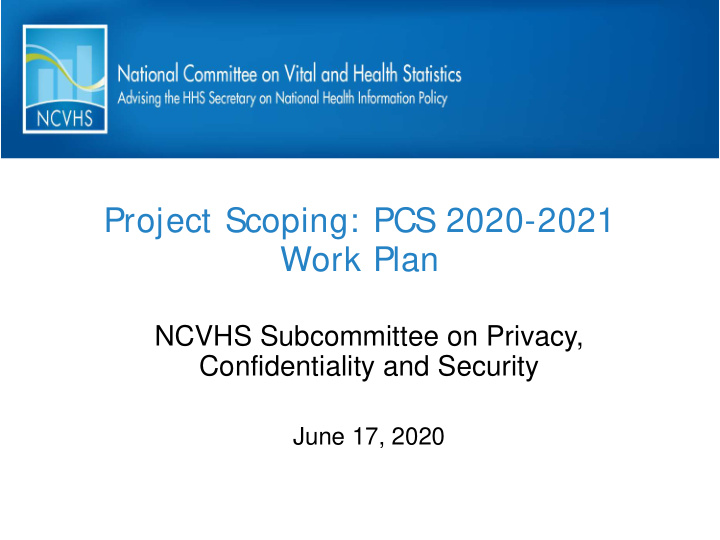



zyxwvutsrqponmlkjihgfedcbaZYXWVUTSRQPONMLKJIHGFEDCBA Project Scoping: PCS 2020-2021 Work Plan NCVHS Subcommittee on Privacy, Confidentiality and Security June 17, 2020
NCVHS zyxwvutsrqponmlkjihgfedcbaZYXWVUTSRQPONMLKJIHGFEDCBA Today’s agenda 10:55 a.m.: Possible Areas of Focus 11:05 – 11:15 a.m.: Scope of Problem 11:15 – 11:45 pm: Themes Discussion 11:45 - 12:00 pm: Next Steps
Potential PCS Focus for 2020-2021 NCVHS I. Short Term Ask: Toolkit for state and local health agencies on how to collect, use, protect, and share data responsibly during a pandemic. II. Long Term A) Trusted public health surveillance infrastructure in the face of new pandemic threats. B) Unexpected or unintended consequences of interoperability rules requiring HIPAA-covered providers to transfer data to non-HIPAA covered entities. C) Secondary topics 1) Artificial intelligence 2) Data on opioid and substance use disorder 3) Standards for terms of service of health apps 4) Conflicts between transparency and data protection 5) Research agenda on de-identification methods
Potential Toolkit Topics NCVHS • What should happen with data in an emergency. • What are fair information principles for a pandemic? • What data should we be collecting? • What rules are all right to override to advance public health, and what should remain in force, and perhaps inalienable? • What level of identification of data is appropriate for which purposes? • When is there a need for identifiable data? • When is aggregate data more appropriate? • Is case-level data without identifiers an adequate compromise? • How do our standards differ at the local / state / federal levels?
One Graphical Perspective
Potential Updated Toolkit Topics, continued • Once collected, where may the data get disclosed? • For what other purposes, if any, should it be used? • How long can we keep it, and what guardrails to we put around it so it’s not misused for law enforcement, immigration, or other purposes that would undermine trust in the public health system?
Case Study NCVHS • If researchers, federal, or state agencies request home addresses or neighborhood/zip code level data of persons who have tested positive for COVID-19 in the past 60 days, what issues may be raised? • Does NCVHS’s past work on a “Toolkit for Communities Using Health Data” (2015) provide a framework for analysis? How might it be updated or supplemented for the current public health crisis?
Guiding principles: NCVHS Promoting Public Health - Accountability - Notice, Consent, and/or Deidentification and other - Risk Mitigation Security -
NCVHS zyxwvutsrqponmlkjihgfedcbaZYXWVUTSRQPONMLKJIHGFEDCBA Waivers as Policy? The U.S. Department of Health and Human Services (HHS) Office for Civil Rights (OCR) released a notice of HIPAA enforcement discretion during the COVID-19 public health emergency: ● Waives penalties for covered entity health care providers or business associates who violate the Privacy Rule for uses and disclosures of protected health information (PHI) by business associates. ● Only applies to certain provisions of the HIPAA Privacy Rule.
Potential Toolkit Update NCVHS • Governmental and Nongovernmental Data Collectors and Users • Non-governmental data stewards: While the current Toolkit mentions that nongovernmental data users and collectors do not have an affirmative duty to share data in an open or transparent manner (14), in a public health emergency, is there an ethical duty to do so with respect to public health authorities (CDC, state governments, et al.)?
Accountable Sharing ● Data Use Agreements and Accountability ● Considerations in Signing DUAs
NCVHS zyxwvutsrqponmlkjihgfedcbaZYXWVUTSRQPONMLKJIHGFEDCBA Ensuring Appropriate Transparency 1. Legal and ethical consequences of an EMR vendor sharing data in violation of a BAA (16). 2. Potential update: In a pandemic or other public health emergency, data users should be required, rather than be encouraged, to provide certain types of community or individual notice (18). 3. If direct individual notice is impossible or impracticable, some form of blanket community notice should be provided on websites or other physical community spaces (19).
Community Involvement • “Nothing about us without us” • Sasha Costanza-Chock, Design Justice • Community Advisory Boards: Increased guidance on what type of community leaders should be included in light of the COVID- 19 pandemic (25). a. For example, in communities where data shows that a church is a place of increased health risk, religious leaders should be on community advisory boards. b. Alternatively, in an area where a meat-packing plant is deemed to be high-risk of spreading COVID-19, both employee representatives (including unions), and employers should be included on the community advisory board.
NCVHS zyxwvutsrqponmlkjihgfedcbaZYXWVUTSRQPONMLKJIHGFEDCBA Accountability • Assign one point person • Accountable for data collection, transfer, and disclosure. • Identifying and responding to lapses in protocol. • Enter Data Use Agreements (DUAs) with organizations requesting data. • Clarifies legal responsibilities in a legally enforceable document.
NCVHS zyxwvutsrqponmlkjihgfedcbaZYXWVUTSRQPONMLKJIHGFEDCBA Security • Comply with HIPAA-mandated administrative, physical, and technical safeguards. • Continually evaluate and reduce security risks in transmitting COVID- 19 patient data.
Recommend
More recommend